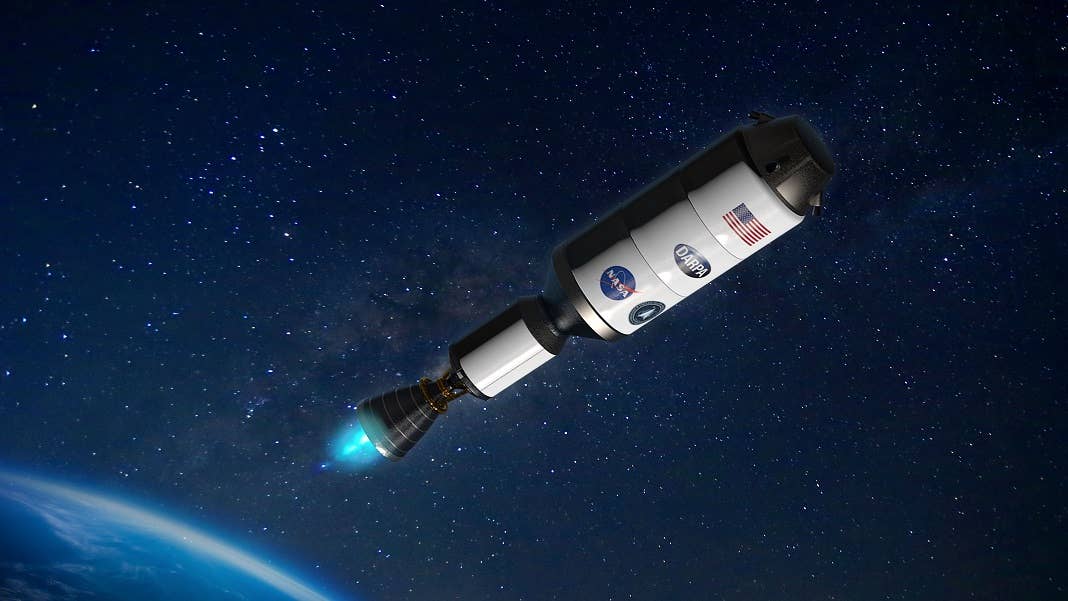NASA’s Building a Nuclear Rocket That Would Get Us to Mars in Just 6 Weeks

Share
Deep space is a hostile environment for humans, which makes the long journey to Mars a serious stumbling block for manned missions. A nuclear-powered rocket could slash the journey time, and NASA has announced plans to test the technology by 2027 at the latest.
Most spacecraft to date have used chemical rockets packed with fuel and oxidizer, which rely on combustion to propel them through space. A nuclear-powered rocket would instead use a fission reactor to heat liquid hydrogen to very high temperatures and then blast it out the back of the spacecraft.
These kinds of engines could be up to three times more efficient than those in conventional rockets, and could cut the time to transit from Earth to Mars from roughly seven months to as little as six weeks. NASA has teamed up with DARPA to make the idea a reality, signing a deal with defense contractor Lockheed Martin to launch a working prototype into space as early as 2025.
"This demonstration will be a crucial step in meeting our moon to Mars objectives for crew transportation into deep space," NASA Deputy Administrator Pam Melroy said in a statement announcing the deal.
This isn’t the first time NASA has explored the idea of a nuclear thermal rocket engine, as the technology is known. The agency’s Project NERVA (Nuclear Engine for Rocket Vehicle Application) ran from the late 50s until the early 70s and saw several prototypes tested on the ground. But the end of the Apollo missions and subsequent cuts in NASA’s budget meant the engine was never tested in space.
The idea has now been revived under the name DRACO, short for Demonstration Rocket for Agile Cislunar Operations. The new name helps explain why DARPA has come on board: the agency thinks the same technology could allow military satellites to maneuver more rapidly and efficiently in orbit to avoid being targeted by enemies.
The contract signed last week will see Lockheed Martin design, build, and test the spacecraft, while Virginia-based BWX Technologies is responsible for designing the nuclear reactor. While the reactors used in Project NERVA relied on weapons-grade uranium, DRACO will use a less enriched fuel known as high-assay low-enriched uranium (HALEU).
This reactor won’t be switched on until the vehicle is in orbit to avoid the risk of a nuclear accident at launch. It will be lofted to an altitude of between 435 and 1,240 miles, which is high enough that the rocket will stay in orbit for at least 300 years, giving time for radioactive materials to decay to safe levels before it returns to Earth.
Be Part of the Future
Sign up to receive top stories about groundbreaking technologies and visionary thinkers from SingularityHub.


Once there, the reactor will be fired up and used to heat cryogenically-cooled liquid hydrogen. As the propellant rapidly rises from minus 420 degrees Fahrenheit to as high as 4,400 degrees, it expands dramatically and the resulting gas is pushed through a nozzle to propel the spacecraft.
The vehicle isn’t expected to carry out any complicated maneuvers; the idea is to simply validate that the design works and collect data on its operation. And according to Live Science, storing liquid hydrogen at cryogenic temperatures for extended periods in space is likely to prove as much of a challenge as getting the reactor to work safely.
If the tests are successful, though, a nuclear-powered rocket engine could have a host of benefits. Their efficiency means they could run for a much longer time than chemical rockets, allowing the spacecraft to hit much higher velocities. That could make it possible to reach Mars in just 45 days, which would significantly reduce astronauts’ exposure to radiation in deep space and the negative mental effects of being cooped up in a tin can for months at a time.
The design requires less propellant to be carried, freeing up space for more equipment and other important payloads. The reactor could also double as a reliable power source for the astronauts once they reached the red planet.
While it might be some time before the idea is ready for prime time, it seems like nuclear-powered rockets may be key to humanity’s goal of venturing deeper into the solar system.
Image Credit: NASA
Related Articles

The Era of Private Space Stations Launches in 2026

Data Centers in Space: Will 2027 Really Be the Year AI Goes to Orbit?

Scientists Say We Need a Circular Space Economy to Avoid Trashing Orbit
What we’re reading
